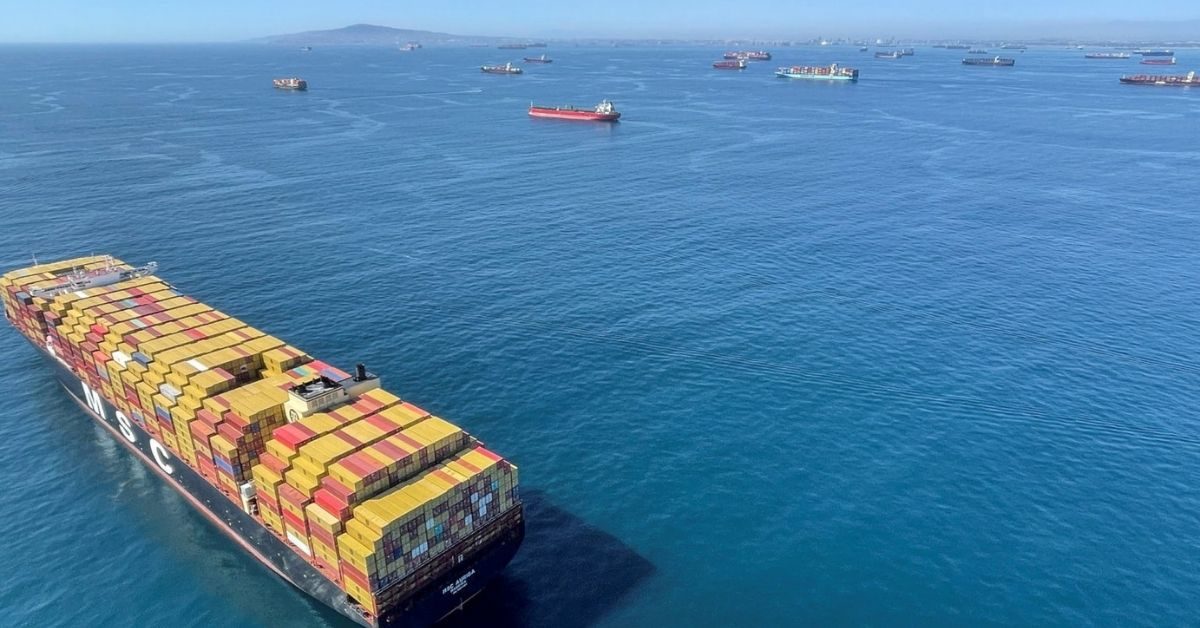Beginning November 16th, a new process for containerships bound for the nation’s two busiest container ports will have ships waiting at least 150 miles from shore, rather than in anchorages and loitering areas closer to the coast.
The new process was designed to improve safety and air quality off of Southern California while also “dramatically reducing” the number of backlogged ships at anchor close to shore near the ports of Los Angeles and Long Beach. The plan was developed by a working group of maritime industry stakeholders including Pacific Maritime Association, Pacific Merchant Marine Shipping Association and Marine Exchange of Southern California, a Coast Guard affiliated organization that manages vessel traffic services (VTS) for the region, as well as others.
“This process will allow vessels to slow their speed and spread out, reducing vessels at anchor before the onset of winter weather, in addition to reducing emissions near the coastline,” the organizations said in a statement.
According to the announcement, the new process calls for inbound containerships arriving from across the Pacific to wait for an available berth approximately 150 miles off the Southern California coast, rather than at anchor in designated anchorages or in loitering areas. The 150-mile boundary will apply only to eastbound ships, while northbound/southbound ships must remain more than 50 miles from shore.
Also, each ship will be assigned a place in the arrival queue based on their departure time from their last port of call, rather than the current system which has ships entering the queue based on when they cross a line 20 nautical miles from the San Pedro Bay Port Complex.
Vessels will be able to come into harbor for fuel, crew changes and regular business, per normal procedures, and the new process does not apply to ships already in the queue, the announcement said.
The new process effectively closes anchorages and loitering areas (previously called holding or drift areas) to arriving transpacific containerships and forces them to drift much further out to sea or slow steam their way across the Pacific Ocean, considering the queue will now be based on the last departure date.
“The new container vessel queuing process creates a fair and transparent system to reduce vessels at the anchor near the Ports of Los Angeles and Long Beach,” said PMA CEO Jim McKenna. “Designed through strong collaboration between PMA, PMSA and Marine Exchange of Southern California, this new procedure will improve air quality while helping ensure ports operate as efficiently as possible.
You may have heard… the backlog of containerships at the neighboring ports of Long Beach and Los Angeles has reached record highs in recent weeks with close to 80 containerships either at anchor or loitering offshore in holding areas. This comes amid packed marine terminals and unprecedented demand for imported consumer goods dating back to the summer of 2020.
As we have seen with the Southern California oil spill (where the cause is being investigated to be a containership dragging anchor in heavy weather), the sheer number of ships creates safety and environmental hazards, while stronger winter storms pose their own challenges. Higher levels of hazardous nitrogen dioxide emissions have also been observed in these areas, partly due to the increase in maritime traffic.
Captain Louttit of the Marine Exchange further explained the changes in a Facebook post Friday night, as the queue of vessels waiting off the ports reached a new record of 83.
“The new voluntary system developed by industry takes advantage of satellite communications with each ship such that the ships will be queued to go to a dock/berth when they DEPART their last port before LA/LB rather then the 100-year-old system when they ARRIVE in LA/LB. This will increase safety and air quality by allowing ships to spread out over the wide Pacific while they wait their turn to go to their dock/berth, and/or “slow speed steam” across the Pacific, saving fuel and reducing emissions, arriving just in time for their berthing/dock date/time rather than anchoring or loitering off LA/LB. Pre-COVID, container ships rarely anchored (0-1 container ship anchored was “normal.” See blue line on container ship graph attached). Loitering hasn’t been done since 2004, and then, half a dozen ships…. It will take 1-2 months to clear the current queue of 83 container vessels waiting to enter port already here, but the steps taken voluntarily by industry to quickly develop this voluntary program are remarkable, and will increase both safety and air quality.”
Under the new process, vessels will be prohibited from operating in the so-called “Safety and Air Quality Area.”
“The San Pedro Bay Ports play a critical role in California’s statewide economic health,” said PMSA President John McLaurin. “This system delivers a pragmatic solution through order and predictability that will reduce the number o ships idling off the coast in the coming months, improve safety, and support the efficient movement of container-based goods.”
“A safe, secure, efficient, reliable and environmentally sound marine transportation system is essential to our economy, which is why the new system is so vital,” said Marine Exchange of Souther California Executive Director Capt. James Kipling Louttit. “Our organization is thrilled to have helped develop a process that relies on comprehensive, real-time data to support the health of our ports.”
Source : G Captain







